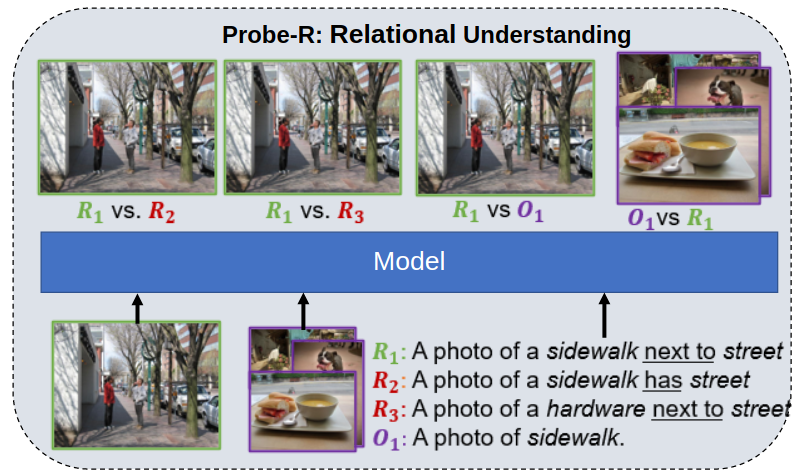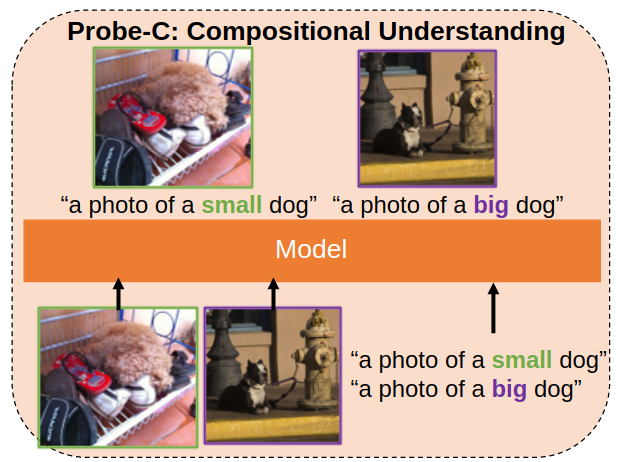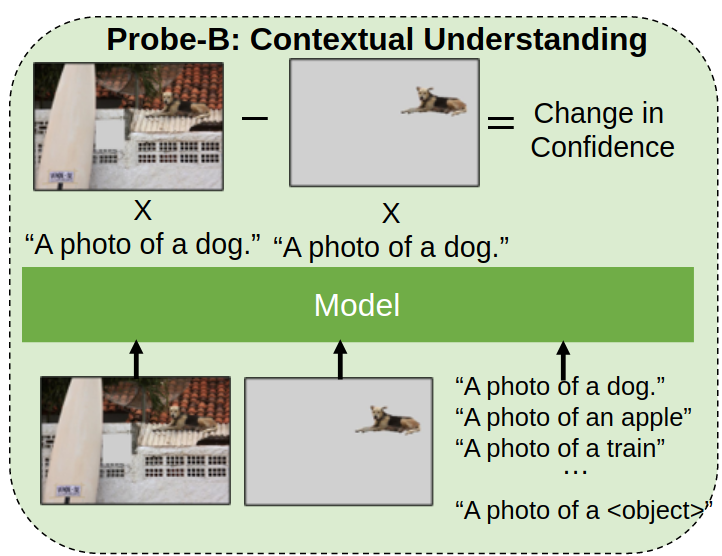We present a novel framework for probing and improving relational, compositional and contextual understanding of large visual-language models (V+L). While large V+L models have achieved success in various downstream tasks, it is not clear if they have a conceptual grasp of the content. We propose a novel benchmarking dataset for probing three aspects of content understanding. Our probes are grounded in cognitive science and help determine if a V+L model can, for example, determine if snow garnished with a man is implausible, or if it can identify beach furniture by knowing it is located on a beach. We have experimented with 5 well known models, such as CLIP and ViLT, and found that they mostly fail to demonstrate a conceptual understanding. That said, we find interesting insights such as cross-attention helps learning conceptual understanding. We use these insights to propose a new finetuning technique that rewards the three conceptual understanding measures we proposed. We hope that the presented benchmarks will help the community assess and improve the conceptual understanding capabilities of large V+L models.
Requires:
python>=3.8torch>=1.13.1transformers==4.27.0.dev0
pip install -r requirements.txtChange L304 to your conda environment path.
conda env create -f environment.ymlDetailed information about the datasets are here: README.md
Download data here
This analysis focuses on testing the model on understanding relations. Models are presented with an anchor image that
contains a annotated, ground-truth relation. The ground truth prompt
An example on how to call for a specific model:
conda activate probe_v
save_dir=/home/mschiappa/eval_TEST/
home_dir=/home/mschiappa/UnderstandingVisualTextModels
root_image_dir=data/visual_genome/val2014/
annot_dir=data/visual_genome/annotations/
python UnderstandingVisualTextModels/core/eval_relation_understanding.py \
--model bridgetower \
--save_dir $save_dir \
--annot_dir "${annot_dir}" \
--root_image_dir "${root_image_dir}"A log.txt file will be produced and stored under: <save_dir>/relation_text_eval/<model>/log.txt
Results for this will be stored in a json file under:
<save_dir>/relation_text_eval/<model>/results/<model>/eval_relation_understanding.json<save_dir>/relation_text_eval/<model>/results/<model>/eval_aggregated_relation_understanding.json
The format of results for each aggregated .json are:
{"rel_diff": {
"rel1_image": {
"rel1_vs_rel3": <logit for $R_1$ when compared to $R_3$>,
"rel1_vs_obj1": <logit for $R_1$ when compared to $O_1$>,
"rel1_vs_rel2": <logit for $R_1$ when compared to $R_2$>
},
"obj1_images": {
"obj1_vs_rel1": <logit for $O_1$ when compared to $R_1$>
}
}
}
This analysis presents two images that either share the same object or share the same attribute to an object (ex. color) but differ in the opposite. For example, switching composition would show an image with "a small dog" versus "a big dog" and switching the object would show images with "a wooden bench" versus "a wooden bed". The model is "asked" to match the correct prompt to the correct image.
An example on how to call for a specific model:
conda activate probe_v
save_dir=/home/mschiappa/eval_TEST/
home_dir=/home/mschiappa/UnderstandingVisualTextModels
root_image_dir=data/coco/val2014/
annot_dir=data/coco/annotations/
python UnderstandingVisualTextModels/core/eval_compositional_understanding.py \
--model bridgetower \
--save_dir ${save_dir} \
--home_dir ${home_dir} \
--root_image_dir "${root_image_dir}"A log.txt file will be produced and stored under: <save_dir>/compositional_text_eval/<model>/log.txt
Results for this will be stored in a json file under:
<save_dir>/compositional_text_eval/<model>/results/eval_compositional_switching_composition_understanding.json<save_dir>/compositional_text_eval/<model>/results/eval_compositional_switching_object_understanding.json<save_dir>/compositional_text_eval/<model>/results/eval_aggregated_compositional_switching_composition_understanding.json<save_dir>/compositional_text_eval/<model>/results/eval_aggregated_compositional_switching_object_understanding.json
The format of results for each aggregated .json are:
{"rel_diff": {
"image1":
{
"prompt1": <mean logit matching prompt>,
"prompt2": <mean logit non-matching prompt>,
},
"image2": {
"prompt1": <mean logit non-matching prompt>,
"prompt2": <mean logit matching prompt>
}},
"acc": {
"text_correct": <accuracy on matching text to image>,
"image_correct": <accuracy on matching image to text>,
"group_correct": <accuracy on both directions>
}
}This compares images by changing the background. The first is the anchor image where the image is kept the same. The next is an image with a random patch that does not cover any annotated objects. The third is where all background is replaced with a filler. The filler options are:
blackgrayscenenoise
An example on how to call for a specific model:
conda activate probe_v
root_image_orig_dir=data/coco/val2014/
root_image_patch_dir=data/coco/val2014_random_patch_dataset
root_image_mod_dir=data/coco/val2014_background_removed_dataset
annot_dir=data/context
save_dir=results
FILL_TYPES="
scene
noise
black
gray
"
for FILL in $FILL_TYPES
do
echo "Running BridgeTower with fill ${FILL}"
python UnderstandingVisualTextModels/core/eval_context_understanding.py \
--model bridgetower \
--save_dir ${save_dir} \
--root_image_mod_dir "${root_image_mod_dir}" \
--root_image_patch_dir "${root_image_patch_dir}" \
--root_image_orig_dir "${root_image_orig_dir}" \
--annot_dir ${annot_dir} \
--fill_type $FILL
doneA log.txt file will be produced and stored under: <save_dir>/context_text_eval/<model>/log.txt
Results for this will be stored in a json file under:
<save_dir>/context_text_eval/<model>/results/<model>/eval_context_background_<filler>_understanding.json<save_dir>/context_text_eval/<model>/results/<model>/eval_aggregated_context_background_<filler>_understanding.json
The format of results for each aggregated .json are:
{
"gt_ap": <AP of all objects in original image>,
"mod_ap": <AP of all objects in image with all background removed>,
"patch_ap": <AP of all objects in image with random patch in background>,
"change_gt_mod_ap": <Change in AP between original image and background replaced image>,
"change_gt_patch_ap": <Change in AP from original image and image with random background patch>,
"change_patch_mod_ap": <Change in AP from image with background patch and image with background replaced>,
"relative_robustness_gt_mod_ap": <Relative change in AP between original image and background replaced image>,
"relative_robustness_gt_patch_ap": <Relative change in AP between original image and patch in background image>,
"relative_robustness_patch_mod_ap": <Relative change in AP between background patch image and background replaced image>,
"change_gt_mod_conf": <Mean change in logit scores between original image and background replaced image>,
"change_patch_mod_conf": <Mean change in logit scores between random patch image and background replaced image>,
"change_gt_patch_conf": <Mean change in logit scores between original image and background patch image>
}This compares images by changing the background AND other objects in the image. The first is the anchor image where the image has the background replaced but all objects are present. The next is an image with a random patch that does not cover any annotated objects. The third is where all background is replaced with a filler AND all other objects are removed. The model is being measured by how well it can detect the remaining object when all other objects are there compared to when they are not. The filler options are:
blackgrayscenenoise
An example on how to call for a specific model:
conda activate probe_v
root_ima
root_image_orig_dir=data/coco/val2014_background_removed_dataset
root_image_patch_dir=data/coco/val2014_random_patch_dataset
root_image_mod_dir=data/coco/val2014_background_removed_and_cooccurrence_dataset
annot_dir=data/context
save_dir=results
FILL_TYPES="
scene
noise
gray
black
"
for FILL in $FILL_TYPES
do
echo "Running ${MODEL} with fill ${FILL}"
python UnderstandingVisualTextModels/core/eval_cooccurence_understanding.py \
--model bridgetower \
--save_dir $save_dir \
--root_image_mod_dir "${root_image_mod_dir}" \
--root_image_patch_dir "${root_image_patch_dir}" \
--root_image_orig_dir "${root_image_orig_dir}" \
--annot_dir ${annot_dir} \
--fill_type ${FILL}
doneA log.txt file will be produced and stored under: <save_dir>/cooccurrence_text_eval/<model>/log.txt
Results for this will be stored in a json file under:
<save_dir>/cooccurrence_text_eval/<model>/results/<model>/eval_aggregated_cooccurence_<filler>_understanding.json<save_dir>/cooccurrence_text_eval/<model>/results/<model>/eval_cooccurence_<filler>_understanding.json
The format of results for each aggregated .json are:
{
"all_objects_ap": [],
"gt_single_object_acc": <acc of single object when background removed but all other objects present>,
"patch_single_object_acc": <accuracy of single object when random patch in background>,
"mod_single_object_acc": <acc of single object when both background and all other objects removed>,
"gt_mod_change_conf": <change in logit score of single object when background removed vs. both background AND objects removed>,
"gt_patch_change_conf": <change in logit score of single object when random patch in background vs. just background removed>,
"patch_mod_change_conf": <change in logit score of single object when patch in background vs. background AND objects removed>,
}Our work is relies on the open-source models built and inspired by several assets. We gratefully thank the authors for their open-source projects that allowed this benchmark to be possible:


